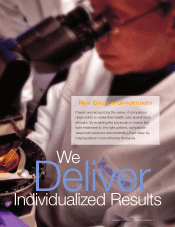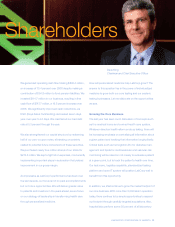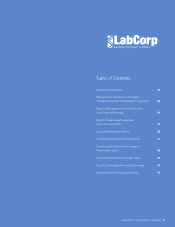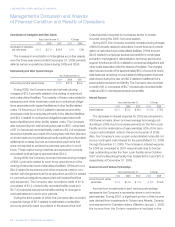LabCorp 2009 Annual Report Download - page 19
Download and view the complete annual report
Please find page 19 of the 2009 LabCorp annual report below. You can navigate through the pages in the report by either clicking on the pages listed below, or by using the keyword search tool below to find specific information within the annual report.
The cost of laboratory testing
accounts for only two to
three percent of health care
expenditures, but infl uences
approximately 70 to 80 percent
of medical decisions. Targeting
the right tests to guide care can
generate exponential returns
for the health care system, and
help patients avoid or control
potentially devastating illnesses.
Consider diabetes, which is
increasing at a rate the Centers
for Disease Control and Preven-
tion (CDC) terms “an epidemic.”
The annual cost to treat and
care for these patients is $174
billion. Yet it costs less than
$20 to perform a blood test to
identify early signs of diabetes
which can encourage patients
to change their diet and lifestyle
and guide appropriate treatment.
Scientifi c studies have shown
that a modest investment in
testing helps patients avoid
cardiovascular events, improves
cancer survival rates and bright-
ens the prognosis for patients
with infectious disease. That’s
a formula that can save millions
in health care costs – and improve
thousands of lives as well.
An Overview of LabCorp’s Business
LABORATORY CORPORATION OF AMERICA 17
OUR
INFRASTRUCTURE
Scale
The Broadest Capabilities
OUR VALUE
A
Compelling
Cost Ratio
The scale and scope of our
national infrastructure allow
us to deliver a broad menu of
tests and services throughout
the United States. Today, our
customer-facing operations
include 1,500 patient service
centers and approximately
7,000 phlebotomists. Our
physician service and logistics
network involves 2,600 couriers
and eight aircraft, while our
physician sales force in the
field includes approximately
1,000 representatives. We
operate 38 primary laboratories
nationwide and eight specialized
Centers of Excellence. In total,
this vast infrastructure allows
us to perform approximately
270 million tests annually for
more than 220,000 clients.
These numbers add up to a
formidable competitive advan-
tage that we have augmented
with ongoing investment in IT
and automation initiatives that
lower our fi xed costs.
























